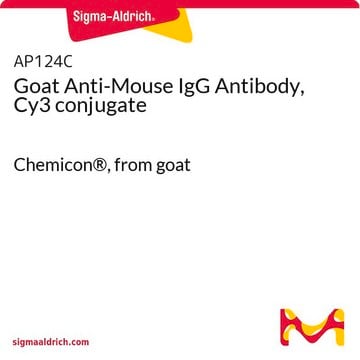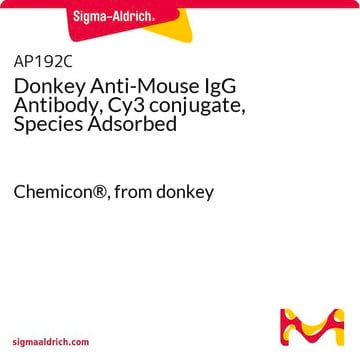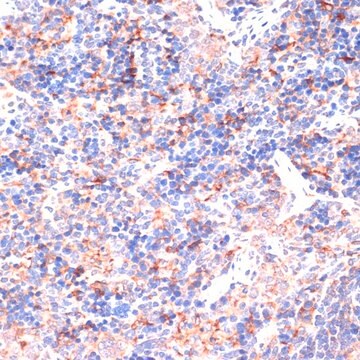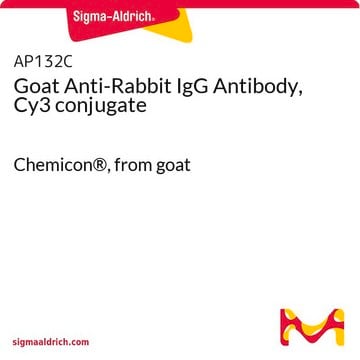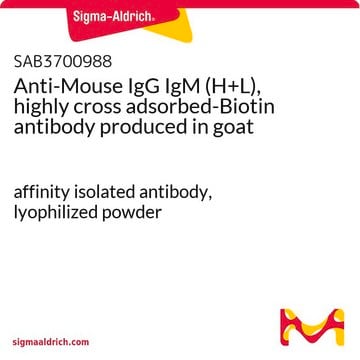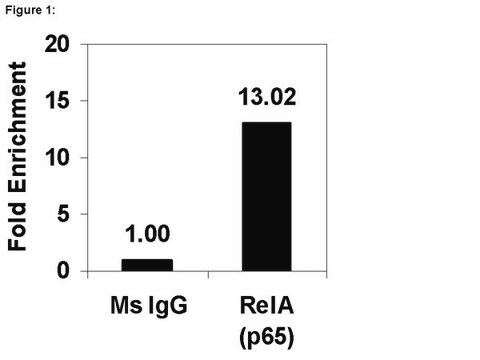AP200C
Goat Anti-Mouse light chain Antibody, Cy3 conjugate
Chemicon®, from goat
Zaloguj sięWyświetlanie cen organizacyjnych i kontraktowych
About This Item
Kod UNSPSC:
12352203
eCl@ss:
32160702
NACRES:
NA.46
Polecane produkty
pochodzenie biologiczne
goat
Poziom jakości
białko sprzężone
CY3 conjugate
forma przeciwciała
affinity purified immunoglobulin
rodzaj przeciwciała
secondary antibodies
klon
polyclonal
reaktywność gatunkowa
mouse
producent / nazwa handlowa
Chemicon®
metody
ELISA: suitable
western blot: suitable
izotyp
IgG
Warunki transportu
wet ice
docelowa modyfikacja potranslacyjna
unmodified
Powiązane kategorie
Opis ogólny
Antibody molecules typically comprise two immunoglobulin light chains covalently bound to a pair of heavy chains. Immunoglobulin light chains occur in two types, designated by the Greek letters kappa and lambda. Kappa and gamma light chains are approximately 250 amino acids in length with an average mass of about 25 kDa. The ratio of kappa to lambda found in the immunoglobulin population varies by species.
Specyficzność
Minimal cross-reaction with bovine, goat, horse, human, rabbit, rat, and sheep.
The antibody reacts strongly with native primary antibodies primarily with kappa light chains. It is not suitable for detecting lambda light chains. The antibody does not react with the heavy chain of mouse IgG. The antibody has been tested by ELISA and adsorbed to ensure minimal cross-reaction with bovine, goat, horse, human, rabbit, rat, and sheep immunoglobulins.
Immunogen
Epitope: Kappa light chain
Prepared from purified mouse IgG light chain.
Zastosowanie
Suggested dilutions:
Western Blotting: 1:100 -1:800 of the 1 mg/mL stock
ELISA: 1:100 -1:800 of the 1 mg/mL stock
Optimal working dilutions must be determined by the end user.
Western Blotting: 1:100 -1:800 of the 1 mg/mL stock
ELISA: 1:100 -1:800 of the 1 mg/mL stock
Optimal working dilutions must be determined by the end user.
Research Category
Secondary & Control Antibodies
Secondary & Control Antibodies
Research Sub Category
Fragment Specific Secondary Antibodies
Fragment Specific Secondary Antibodies
This Goat anti-Mouse light chain Antibody, Cy3 conjugate is validated for use in ELISA, WB for the detection of Mouse light chain.
Opis wartości docelowych
25 kDa
Postać fizyczna
ImmunoAffinity Purified
Lyophilized powder from a solution with 0.01M Sodium Phosphate, 0.25M NaCl, pH 7.6, 0.05% Sodium Azide. 15 mg/mL BSA as stabilizer. Purified by immunoaffinity chromatography.
Przechowywanie i stabilność
Maintain lyophilized product at 2°-8°C for up to 12 months. After reconstitution the product is stable for six weeks at 2°-8°C in the dark as an undiluted liquid. Reconstitute vial with of distilled water (addition of 0.5 ml water will yield a final concentration of 1 mg/mL). For extended storage after reconstitution, add an equal volume of glycerol to make a final concentration of 50% glycerol followed by storage at -20°C in undiluted aliquots for up to 12 months. Please note the concentration of protein (and buffer salts) will decrease to one-half of the original after the addition of glycerol. Avoid repeated freeze thaw cycles. Keep away from light.
Informacje prawne
CHEMICON is a registered trademark of Merck KGaA, Darmstadt, Germany
Oświadczenie o zrzeczeniu się odpowiedzialności
Unless otherwise stated in our catalog or other company documentation accompanying the product(s), our products are intended for research use only and are not to be used for any other purpose, which includes but is not limited to, unauthorized commercial uses, in vitro diagnostic uses, ex vivo or in vivo therapeutic uses or any type of consumption or application to humans or animals.
Not finding the right product?
Try our Narzędzie selektora produktów.
Zwroty wskazujące rodzaj zagrożenia
Zwroty wskazujące środki ostrożności
Klasyfikacja zagrożeń
Aquatic Chronic 3
Kod klasy składowania
11 - Combustible Solids
Klasa zagrożenia wodnego (WGK)
WGK 3
Certyfikaty analizy (CoA)
Poszukaj Certyfikaty analizy (CoA), wpisując numer partii/serii produktów. Numery serii i partii można znaleźć na etykiecie produktu po słowach „seria” lub „partia”.
Masz już ten produkt?
Dokumenty związane z niedawno zakupionymi produktami zostały zamieszczone w Bibliotece dokumentów.
Nasz zespół naukowców ma doświadczenie we wszystkich obszarach badań, w tym w naukach przyrodniczych, materiałoznawstwie, syntezie chemicznej, chromatografii, analityce i wielu innych dziedzinach.
Skontaktuj się z zespołem ds. pomocy technicznej